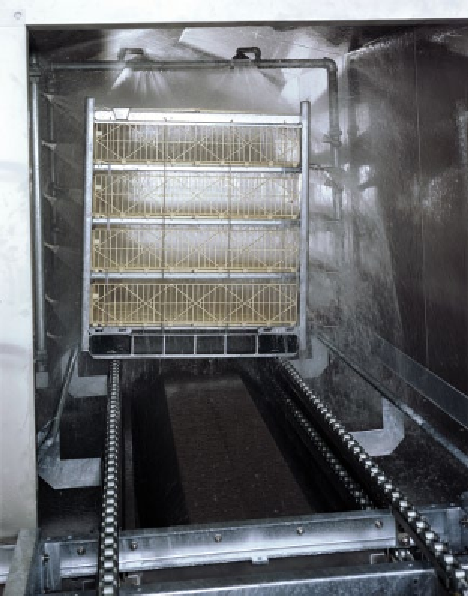Agriculture Reference
In-Depth Information
control of relative humidity is also essential, and this
should not be allowed to rise above 70%.
The method of unloading will obviously depend upon
the type of crate used. Loose crates are unloaded from
the vehicle and placed on a conveyor system which car-
ries them to the hanging station. It is important that the
crates are not thrown around roughly and that the birds
are gently but firmly hung on the rail. The crates con-
tinue around on the conveyor, are washed and brought
back to the vehicle, which should have been cleaned.
For unloading the birds from fixed crates, the vehicle
is driven between two vertically moving platforms. The
hangers standing on the platforms open the crates at the
side, take out the birds and hang them on the killing line
which is behind them. No crate conveyor system is
required but the crates are extremely difficult to clean. In
addition, the hangers have to turn through 180° every
time a bird is removed and hung on the line.
Some of the modular systems effect unloading through
hinged doors in the side in a manner similar to that for
fixed crates. Another system raises the modules hydrau-
lically to a high-level unloading platform, so that the
drawers are at the required level. The birds are taken
from the open drawers and hung on the shackles by a 90°
rotation of the unloading operative. The 'Easyload'
module is removed from the transport vehicle, either by
a forklift truck or automated unloader, and fed into an
automated system which presents it to a drawer push-out
unit. This transfers the plastic drawers to a covered
conveyor leading to the hanging station. The open drawer
allows unrestricted access for the hanging operatives,
greatly reducing bird damage and manpower require-
ments. The birds are hung directly on the killing line.
Each operator can hang 1000-1100 birds/hour. The
hanging area can be enclosed to incorporate dust extrac-
tion and light density control, thus aiding health and
safety for the operators and welfare of the birds, which
allows them to be quiet and lessens stress during transfer
onto the killing line.
The empty 'Easyload' drawers are automatically
inverted to remove all loose debris and are then immersed
in a pre-soak tank before being thoroughly washed and
sanitised. The empty drawers continue through the
drawer re-inverter to be automatically reloaded into the
returning empty module frame. The module frames are
also automatically washed (Fig. 10.4).
The layout of this system lends itself to separate clean
and dirty areas within the arrival bay.
Figure 10.4
Washing crate module (Reproduced with permission
from Stork Poulty Processing, Boxmeer, The Netherlands).
become trapped by the heads, legs or wings. This is a
legal requirement, and all birds must be assessed by the
site official veterinarian (OV).
The lighting in the hanging-on area should be suffi-
cient to enable staff to see the birds and identify prob-
lems but not so bright as to disturb the birds. On
removal from the crate or module, birds should be
checked to see whether they are suffering from a condi-
tion which may cause them pain or distress. These
birds should be killed immediately either by dislocation
of the neck (small birds) or by stunning knife (small
and large birds). This must be done by a licensed
slaughterman. Runts and diseased birds, which may
have been inadvertently crated, should also be killed
and not shackled.
Shackling
When correctly handled, most birds remain still after a
short period of wing flapping when first placed in the
shackles. Broilers will generally have settled within 12
seconds and turkeys 20 seconds. A method of reducing
wing flapping is for the shackler to run his or her hands
down the bird's body or to briefly hold on to its legs. A
strip of smooth plastic sheeting installed parallel to the
conveyor line, along which the breasts of the suspended
Pre-slaughter inspection
On arrival at the plant, every consignment should be
checked to determine the condition of the birds and to
ensure, for example, that during transit they have not

